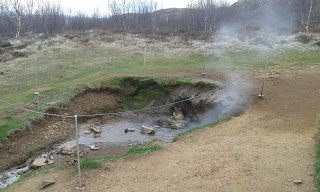Day 4
Exploring Contexts, or
What does it mean to be an Icelander?
We leave early in the morning, heading towards the centre of Iceland's identity.
Independent People, is the title of the novel of the most famous and beloved of Icelandic writers, Halldo Laxness, who was awarded the Nobel Prize for Literature in 1955. An Independent People is what Icelanders proud themselves to be.
They have resisted centuries after centuries in this inhospitable rock in the Atlantic Ocean. They have recovered from economic crises, they have conquered independence from Denmark.
Today we want to discover the way a nation builds its own identity.
On the way we see Laxness's house. He built it with his own hands, in the middle of a barren lava field.
First stop, Thingvellir (in Icelandic it is spelt Þingvellir). The site of the first Icelandic parliament.
It's a wide plain around a lake, with snowcapped mountains looming large at the horizon.
It's cold and windy. More windy than cold, but difficult to bear nonetheless.
I had read about Thingvellir in the novels of Arnaldur Indridason, because it is the place where the most important national celebrations are held.
The place looks quite remote. Difficult to identify any specific feature that can make it ourtstanding or worth the nomination ad UNESCO heritage site.
It is more the shrine of an idea. Nation, freedom, independence.
Second stop. Geysir.
Not really the original one, which even though officially in activity does not erupt regularly.
The one that is in action is called Strokkur. It erupts every 5-8 minutes. The water gurgling, swelling, erupting, and flushing down in the pit is nice to look at, in spite of the cold wind that bends us.
All around there are hot springs and pools of boiling mud.
The wind is really strong. It's about time for a nice cup of koffi in the visitors' centre nearby.
Third stop. Gullfoss waterfall.
There is not so much to say about it. You have to see it, to hear it, to feel it.
It is not exeptionally big, but the water thunders relentlessly down a gorge, tumbling on the rocks, roaring around.
An impressive show of nature.
Last stop, the peaceful crater of Kerid (Kerið) where the blue waters of the lake contrast with the stormy wind that almost ravishes you all around the cavity.
Our trip is over.
Have we understood any better what people feel around here?
And besides all the view and the feelings, there are the stories. Hundreds, thousands of them.
Each place has loads of stories to tell, and our tour leader introduces us to many of them.
The invisible people, the trolls, the elves, the Yule Lads.
Stones are petrified people, waterfalls tell stories of impossible loves or of the determination of a poor woman who did not want to see nature transformed into power plants.
This is possibly the most impressive thing of the day.
It is often said that Icelanders believe in the existence of other beings. It is now probably less difficult for us to understand why.
Whatever the place, it is important to know it to understand better the people who live in it.
REFLECTIVE JOURNAL
What is it
to be an Icelander?
How
important is it to know the environment of students’ life?
Nature
speaks of a country where fantasy is stirred by the landscape, and where
self-reliance is essential.







No comments:
Post a Comment